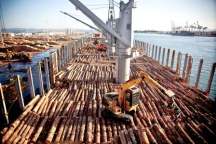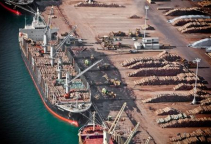CORRECTION:
Editor’s Note: The Kaingora Forest in New Zealand is considered the largest man-made forest at 190,000 hectares.
See more HERE:
| The Kaingaroa Forest, spanning 190,000 ha of plantable land, is one of the crown jewels of international forestry and one of the oldest and largest softwood plantations in the world.
It is recognized worldwide as an intensively tended forest that produces up to 4 million m³ of high-quality logs per annum. |
 |
 |
The Kaingaroa Forest plantation is owned by Kaingaroa Timberlands, a partnership of investors. Kaingaroa Timberlands is proud to own this fine estate, and as a major supplier of logs to the domestic processing industry and export markets in China, Korea, India and other Pacific Rim countries, Kaingaroa Timberlands seeks to be recognized for excellent customer service and high-quality products, as well as a commitment to health and safety, the environment and the community in which we do business
BEIJING, CNW — Chinese President Xi Jinping visited Saihanba Forest Farm in north China’s Hebei Province. Three generations of tree planters’ unremitting efforts have turned the once vast barren land into the world’s largest man-made forest.
During his visit, President Xi listened to the work report by the local government in coordinating the protection and restoration of mountains, rivers, forests, farmland, lakes and grass, indicating that green development will be elevated to a higher position in the country’s modernization drive.

CGTN: Xi Jinping inspects forest farm as eco-friendliness highlighted in high-quality development
Covering an area of about 93,000 hectares, Saihanba almost became a wasteland in the 1950s due to rampant tree felling operations, which also caused sand storms threatening Beijing and adjacent regions.
In 1962, hundreds of foresters embarked on tree planting in Saihanba to change the tide of rapid desertification. After three generations’ hard efforts, the forest coverage has increased from 11.4 percent to 80 percent, currently supplying some 137 million cubic meters of clean water to the Chinese capital.
During the ceremonies honoring those who have contributed to the victory against extreme poverty, Saihanba Forest Farm has conferred the national title of role model. It also won the 2017 Champions of the Earth award, the highest honor of its kind by the United Nations.
Xi talked to some foresters, inspected the growth of trees, and listened to the introduction of the farm’s efforts in carrying forward the Saihanba spirit and promoting high-quality development. Saihanba has become a symbol of the Chinese spirit of hard work and a vivid example of eco-civilization.
Eco-friendly growth pattern
Despite increasing downward pressure over the years, China has been steadfast in resisting the old ways of economic expansion, and their severe impact on the environment. To this end, the top leadership has repeatedly underscored a key development approach as Xi had vividly put as “lucid waters and lush mountains are invaluable assets.”
In June, the General Office of the State Council issued a guideline for adopting scientific measures as part of China’s afforestation efforts to fundamentally improve the country’s natural environment.
It urges efforts to grow trees and grass following the inherent rules of the ecosystem to improve the stability of the ecosystem and its capacity for self-repair.
Xi has paid great attention to adopting a scientific approach to China’s high-quality land greening and has on many occasions called for more efforts in promoting afforestation and protecting forest resources.
According to forestry and grassland authorities, China has successfully halted the expansion of desertification, with the desertification area shrinking by an annual average of 2,424 square kilometers.